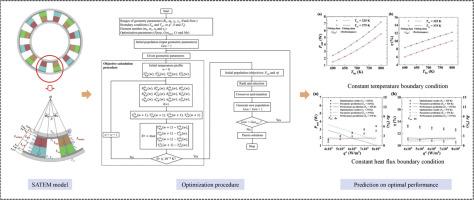分段环形热电模块高效优化设计方法的综合研究
IF 9.6
Q1 COMPUTER SCIENCE, ARTIFICIAL INTELLIGENCE
引用次数: 0
摘要
针对传统数值模拟方法在确定热电模块最优结构参数时建模过程复杂、计算效率低、对多目标设计适应性差等局限性,本文介绍了一种将均匀等效单元积分法与多参数多目标优化算法相结合的分段环形热电模块在恒温和热流边界条件下的高效结构优化方法。优化结果表明,最优电阻比与边界条件无关,在本研究的所有研究情况下,最优热电腿比保持在1.2左右。值得注意的是,在所有条件下,优化后的分段环形热电模块的最佳分段比对其两端的温度高度敏感,并且可以使用所提出的拟合公式直接计算。此外,分段环形热电模块存在最佳总热电腿角,以实现热电材料工作温度范围内的最大温差。优化后的分段环形热电模块输出功率和效率可以用基于参数的拟合公式进行预测,与直接优化结果相比,相对误差在3%以下。本文提出的方法在建模简单、计算效率高、与机器学习框架高度兼容等方面具有显著优势,从而实现了分段环形热电模块的人工智能辅助设计和优化管道。本文章由计算机程序翻译,如有差异,请以英文原文为准。

A comprehensive study of high-efficiency optimization method on designing segmented annular thermoelectric module
To address the limitations of traditional numerical simulation methods in determining the optimal structure parameters of thermoelectric module, such as complex modeling procedures, low computational efficiency, and poor adaptability to multi-objective design, this paper introduces an efficient structural optimization approach of segmented annular thermoelectric module that combines the uniformly equivalent element integral method and multi-parameter and multi-objective optimization algorithm under both constant temperature and heat flux boundary conditions. The optimization results show that the optimal resistance ratio is independent of the boundary conditions, and the optimal thermoelectric leg ratios remain approximately 1.2 across all studied cases in this study. Notably, the optimal segment ratios are highly sensitive to the temperatures at the two ends of the optimized segmented annular thermoelectric module under all conditions and can be directly calculated using the proposed fitting formulas. In addition, an optimal total thermoelectric leg angle exists for the segmented annular thermoelectric module to achieve the maximum temperature difference within the operating temperature range of the thermoelectric materials. The output power and efficiency of the optimized segmented annular thermoelectric module can be predicted using the parameter-based fitting formulas, with relative errors below 3 % when compared to the direct optimization results. The proposed method in this paper offers significant advantages in terms of modeling simplicity, computational efficiency, and highly compatible with machine learning frameworks, thereby enabling artificial intelligence-assisted design and optimization pipelines for segmented annular thermoelectric modules.
求助全文
通过发布文献求助,成功后即可免费获取论文全文。
去求助
来源期刊

Energy and AI
Engineering-Engineering (miscellaneous)
CiteScore
16.50
自引率
0.00%
发文量
64
审稿时长
56 days
 求助内容:
求助内容: 应助结果提醒方式:
应助结果提醒方式:


